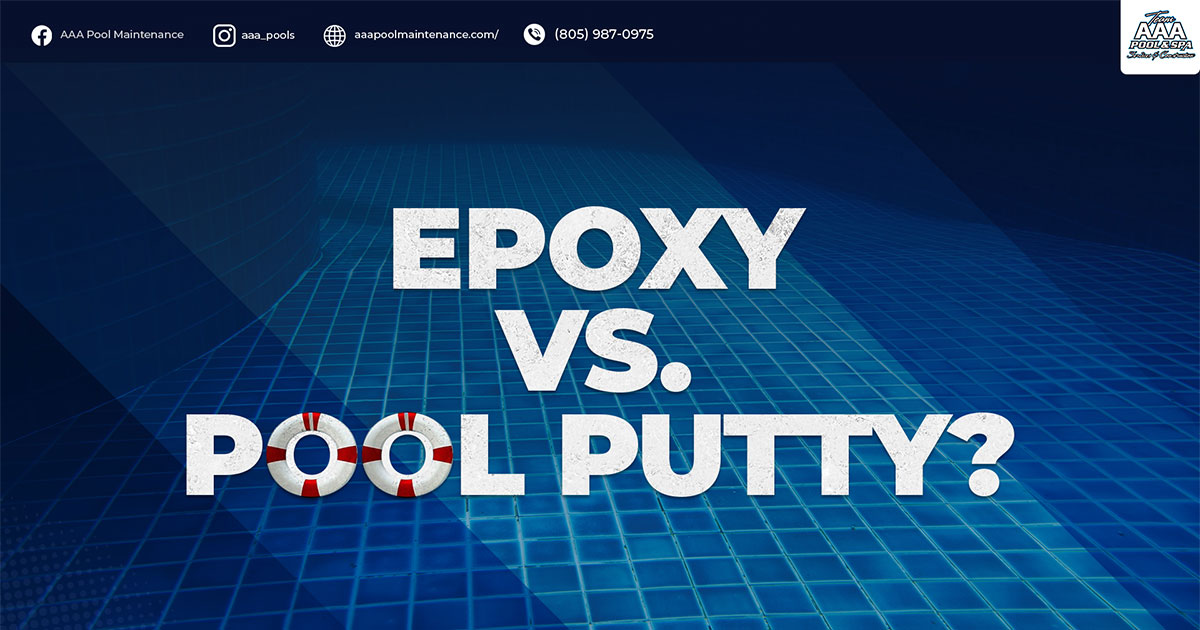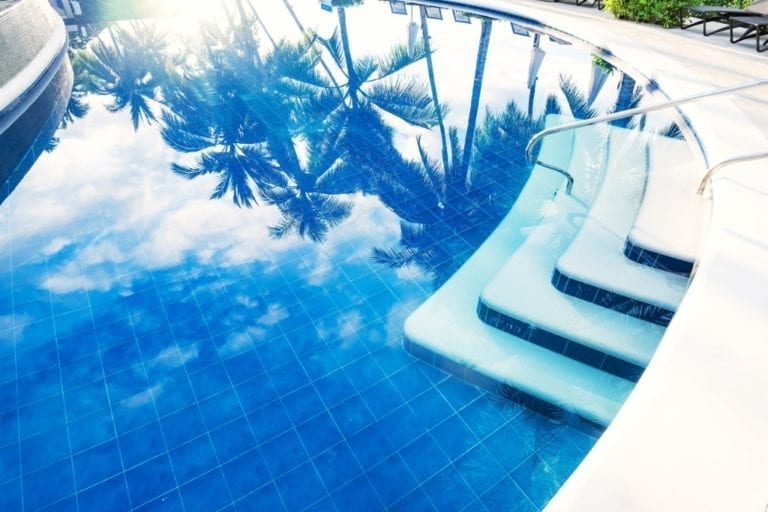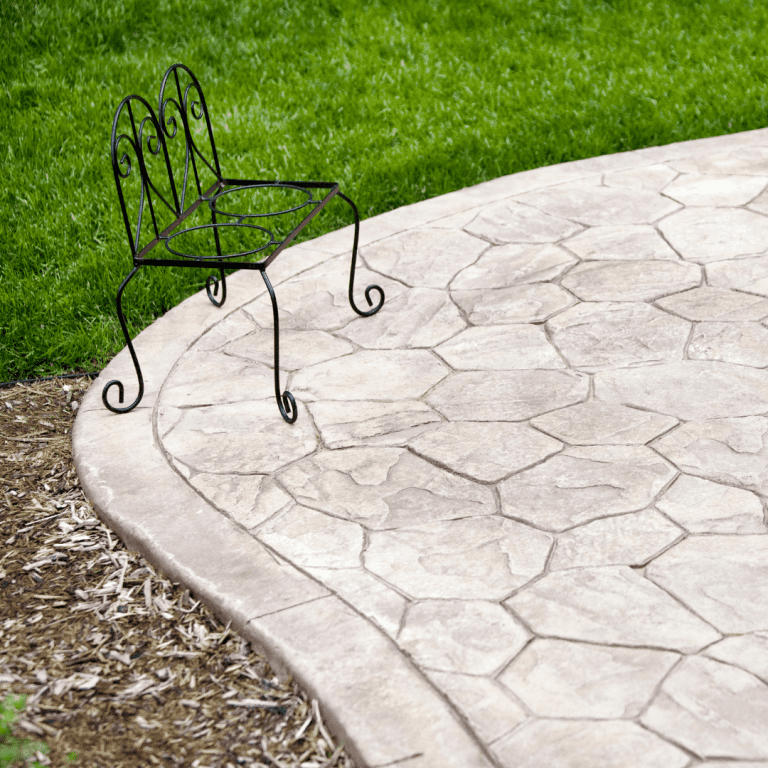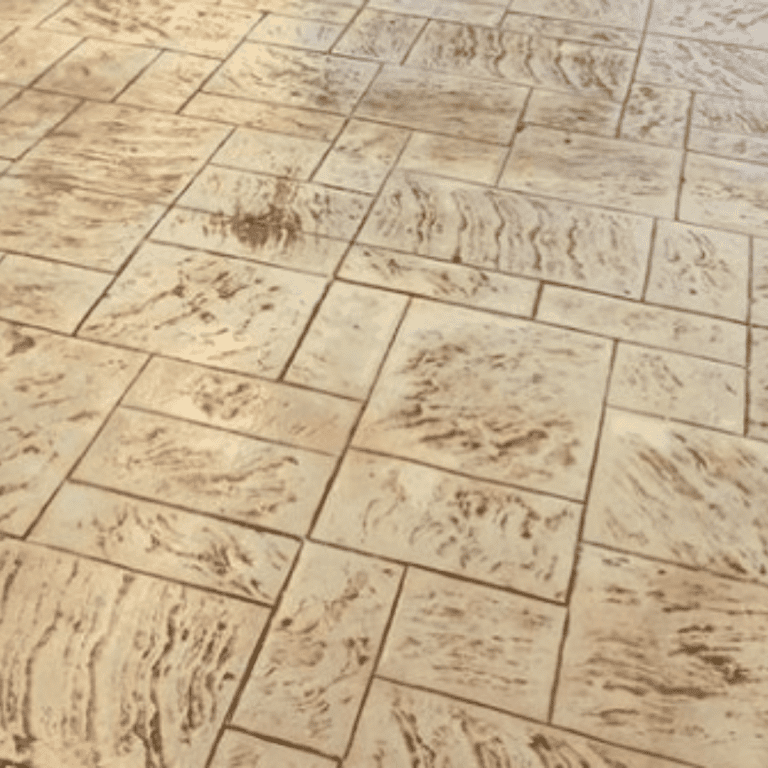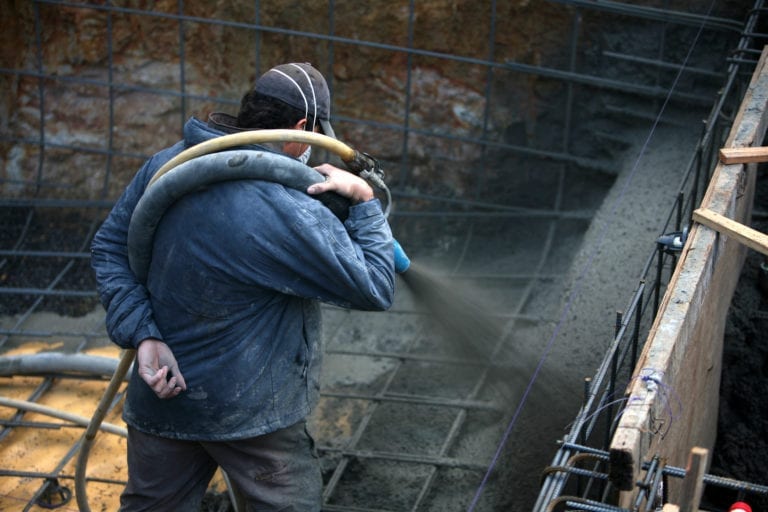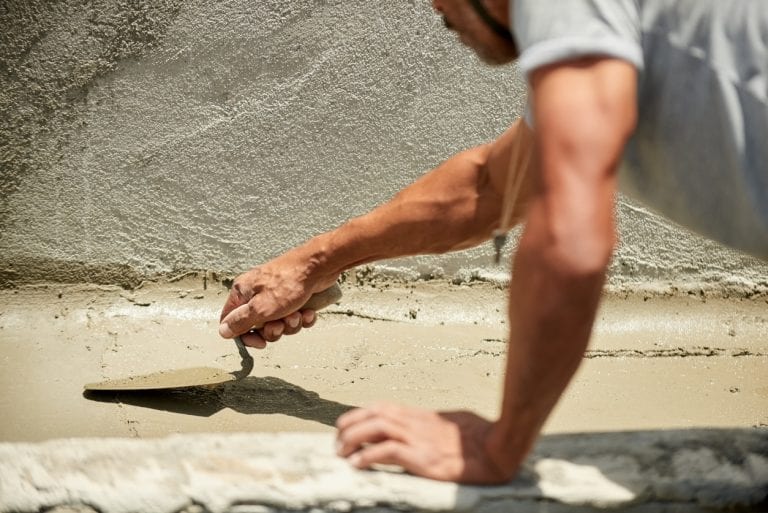When it comes to swimming pool repair, you have a variety of materials to choose from. Two common options are epoxy and pool putty. While they may look similar, it’s important to understand their differences, as they have different properties and serve different purposes. This knowledge will help you determine which material is best suited for your specific pool repair needs.
Show two hands holding a tube of epoxy and a container of pool putty with a swimming pool in the background. The hands should be posed as if the person is trying to decide which product to use for a repair job on the pool surface. The epoxy tube should appear sturdy and industrial, while the pool putty container should look more flexible and malleable. Use blue and green hues to represent the water and give the image a summery feel.
Key Takeaways
- Epoxy and pool putty are commonly used for swimming pool repairs.
- Epoxy is known for its strength, durability, and ability to repair cracks and holes in pipework.
- Pool putty is more affordable, easier to apply, and remains flexible for smaller repairs.
- Epoxy is generally more durable and suitable for larger cracks or permanent repairs.
- Read and follow the manufacturer’s instructions for proper application of both materials.
Pros and Cons of Epoxy
Epoxy is a popular choice for pool repair due to its strong adhesion and durability. However, it is important to consider both the advantages and disadvantages of using epoxy for your pool repairs.
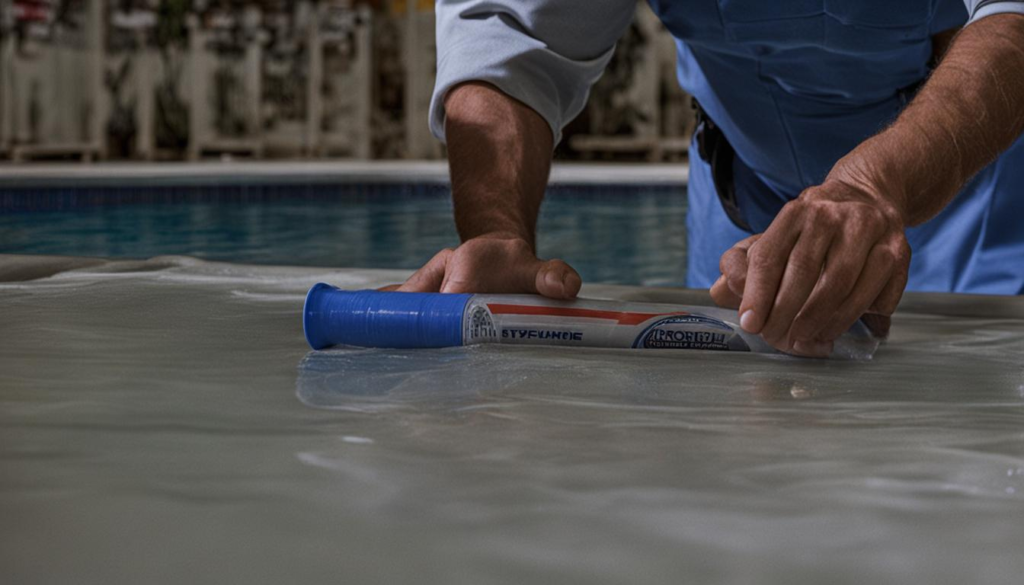
Pros of Epoxy
- Epoxy has excellent adhesive properties, making it highly effective for repairing cracks and holes in pipework.
- It is a waterproof material, which ensures long-lasting repairs and prevents further damage caused by water leakage.
- Epoxy can withstand pressure, making it suitable for repairs in areas that experience high water pressure, such as plumbing connections.
- It is one of the best pool repair products available on the market, known for its strength and durability.
Cons of Epoxy
- Epoxy can be more expensive compared to other pool repair options.
- It requires careful application, following specific humidity parameters and temperatures, for optimal adhesion and curing.
- Applying epoxy can be more time-consuming than other pool repair materials.
While epoxy offers numerous benefits, it may not suit every pool repair situation. It is important to assess the specific needs of your pool and consider alternative options if necessary.
Table: Comparison of Epoxy and Pool Putty
| Factors | Epoxy | Pool Putty |
|---|---|---|
| Adhesion Strength | High | Medium |
| Waterproof | Yes | No |
| Pressure Resistance | High | Low |
| Cost | Higher | Affordable |
| Application Difficulty | Medium | Easy |
As shown in the table, epoxy has higher adhesion strength and better waterproof properties than pool putty. However, pool putty may be a more affordable option, and its easy application makes it suitable for smaller repairs and temporary fixes. Consider the specific requirements of your pool repair project before making a decision.
Pros and Cons of Pool Putty
Regarding swimming pool repairs, pool putty is an alternative to consider. Here are some pros and cons of using pool putty for your pool repair needs:
Pros of Epoxy vs. Pool Putty
- Affordability: Pool putty is generally more affordable than other pool repair materials, making it a budget-friendly option for smaller repairs.
- Ease of Application: Pool putty is easy to apply and does not require any mixing. Shape and mold the putty to the desired area, making it convenient for DIY repairs.
- Versatility: Pool putty can be used to make watertight seals around taps, drains, and other plumbing parts. Its soft and flexible nature allows for easy removal if necessary.

Cons of Pool Putty
- Durability: While pool putty is suitable for smaller repairs, it may not be as durable as epoxy. It may not hold up well for larger cracks or holes in the long run.
- Limited Use: Pool putty is specifically designed for watertight seals and may not be the best option for repairing other types of damage, such as cracks in the pool’s structure.
- Not as Strong: Pool putty does not offer the same level of strength and adhesion as epoxy. It may not be as effective in high-pressure areas or for long-lasting repairs.
Overall, pool putty can be a cost-effective and easy-to-use option for smaller pool repairs. However, for larger or more permanent repairs, epoxy may be a more suitable choice.
Create an image showcasing pool putty alternatives in action, such as using silicone sealant or waterproof epoxy to seal cracks and gaps in a swimming pool. Show the application process and highlight the pros and cons of each alternative. Use vibrant colors to make the image pop and convey a sense of efficiency and effectiveness.
| Pros | Cons |
|---|---|
| Affordable | Not as durable as epoxy |
| Easy to apply | Limited use |
| Versatile | Not as strong as epoxy |
Durability and Longevity
Regarding durability and longevity, epoxy generally outperforms pool putty in swimming pool repairs. Epoxy forms a strong, concrete-like material that can withstand pressure and resist water leaks, making it ideal for permanent fixes and dealing with larger cracks. On the other hand, pool putty, while versatile and easy to apply, may not offer the same level of durability as epoxy and may be more suitable for smaller repairs or temporary fixes.
To illustrate the differences in durability, consider the following:
| Epoxy | Pool Putty | |
|---|---|---|
| Strength | High | Medium |
| Resistance to Pressure | Excellent | Good |
| Resistance to Water Leaks | Excellent | Good |
| Suitability for Larger Cracks | High | Low |
As the table demonstrates, epoxy excels in terms of strength, pressure resistance, and water leak prevention. These qualities make it a preferred choice for long-lasting repairs and addressing significant structural issues. However, it’s important to note that pool putty is still a viable option for smaller repairs and temporary fixes, offering an affordable and flexible solution.
Considering the durability and longevity requirements of your swimming pool repair, it is advisable to consult with a professional contractor experienced in pool maintenance and repairs. They can assess the extent of the damage and recommend the most suitable material and repair method for your specific needs, ensuring the longevity and structural integrity of your pool.
Key Points:
- Epoxy provides superior durability and longevity compared to pool putty.
- Epoxy is recommended for permanent repairs and larger cracks, while pool putty is better suited for small repairs and temporary fixes.
- Consider consulting a professional contractor for expert advice on choosing the right material for your pool repair needs.
Application Methods
When it comes to repairing cracks in your pool, it’s important to understand the different application methods for epoxy and pool putty. Proper application ensures effective repairs and long-lasting results. Let’s take a closer look at how each material is applied.
Epoxy Application
Epoxy typically comes as a two-part compound – resin and hardener – that needs to be mixed together in a specific ratio. To apply epoxy for crack repairs in pools, follow these steps:
- Clean the area around the crack thoroughly, ensuring there is no dirt or debris.
- Mix the epoxy resin and hardener according to the manufacturer’s instructions. Use a clean container and stir well.
- Apply the epoxy mixture to the crack using a putty knife or applicator, ensuring it fills the crack completely.
- Smooth out the epoxy surface with the putty knife or a trowel, making it level with the surrounding area.
- Allow the epoxy to cure as per the manufacturer’s instructions. This usually involves keeping the repair area dry and avoiding any water contact for a specific period of time.
Pool Putty Application
Applying pool putty for crack repairs in pools is relatively straightforward. Here’s how to do it:
- Clean the area around the crack, ensuring it is free of dirt and debris.
- Take a small amount of pool putty and knead it in your hand until it becomes soft and pliable.
- Apply the pool putty directly to the crack, pressing it firmly into place and ensuring it fills the crack completely.
- Smooth out the putty surface with your fingertips or a putty knife, making it level with the surrounding area.
- Allow the pool putty to set and cure as per the manufacturer’s instructions. This may involve keeping the repair area dry and avoiding water contact for a specific period of time.
Remember, it’s important to read and follow the directions provided by the manufacturer for both epoxy and pool putty. This ensures proper application and the best results for repairing cracks in your pool.
Choosing the Right Material for Your Pool Repair Needs
When it comes to swimming pool repair, choosing the right material is essential for a successful and long-lasting solution. Both epoxy and pool putty have their advantages and disadvantages, so it’s important to consider your specific repair needs before making a decision. Here’s a breakdown of the key factors to consider when choosing between epoxy and pool putty:
Repair Size and Scope
The size and scope of your repair project will play a significant role in determining whether epoxy or pool putty is the best choice. Epoxy is recommended for larger cracks and holes that require a strong, durable repair. It forms a concrete-like material that can withstand pressure and resist water leaks. On the other hand, pool putty is more suitable for smaller repairs and temporary fixes. It remains soft and flexible, making it easier to remove if necessary.
Application Complexity
The application process for epoxy and pool putty also differs in complexity. Epoxy typically requires careful mixing of resin and hardener in specific ratios, and it must be applied following the manufacturer’s instructions. Pool putty, on the other hand, is more straightforward and doesn’t require mixing. However, it is still important to carefully read and follow the manufacturer’s directions to ensure proper sealing and repairs.
Budget and Affordability
Consider your budget and affordability when choosing between epoxy and pool putty. Epoxy tends to be more expensive than pool putty, but it offers long-lasting repairs and durability. If you’re working within a limited budget or have smaller repair needs, pool putty may be a more affordable option. However, keep in mind that pool putty may not be as durable as epoxy and may require more frequent repairs in the long run.
In conclusion, selecting the right material for your pool repair needs requires careful consideration of factors such as the size of the repair, application complexity, and your budget. For larger cracks and more permanent repairs, epoxy is often recommended for its durability and strength. Pool putty, on the other hand, is suitable for smaller repairs and temporary fixes. If you’re unsure about the best material for your pool repair needs, it’s always a good idea to consult with a professional pool maintenance and repair contractor.
Create an image of a clear blue swimming pool with cracks and leaks, being repaired with two different materials: epoxy and pool putty. The epoxy is being applied to larger cracks while the pool putty is being used for smaller ones. Show the repair process step-by-step, from cleaning the affected area to applying the materials and smoothing them out. Depict the materials and tools needed for each repair method, including brushes, putty knives, and sandpaper. Make sure to emphasize the difference between epoxy and pool putty in terms of their properties and durability.
| Factors | Epoxy | Pool Putty |
|---|---|---|
| Repair Size and Scope | Recommended for larger cracks and holes | More suitable for smaller repairs and temporary fixes |
| Application Complexity | Requires careful mixing and following instructions | Straightforward and doesn’t require mixing |
| Budget and Affordability | More expensive but offers long-lasting repairs | More affordable but may require more frequent repairs |
Conclusion
When it comes to swimming pool repair, choosing the right material is crucial for long-lasting results. Both epoxy and pool putty have their advantages and can be effective in different situations. Epoxy offers durability and strength, making it ideal for permanent repairs and larger cracks or holes. On the other hand, pool putty provides flexibility and affordability, making it suitable for smaller repairs and temporary fixes.
To ensure the best outcome for your pool repair needs, it is always recommended to consult with a professional contractor. They have the expertise and knowledge to assess the damage accurately and recommend the most suitable solution. Professional contractors also have access to high-quality materials and the skills to apply them correctly, ensuring that your pool is restored to its optimal condition.
If you’re in need of professional pool maintenance and repair services, contact AAA Pool Maintenance at (805) 987-0975. Their team of experts will provide expert advice, assistance, and ensure that your swimming pool is in optimal condition. Don’t let pool repairs become a hassle – let the professionals take care of it for you.

